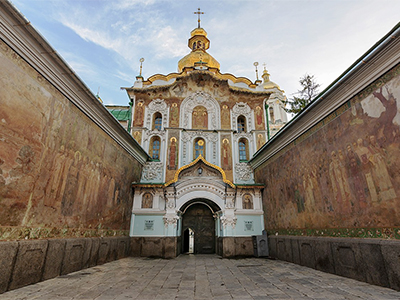 26.04.2023
Ukrainian cuisine
26.04.2023
Ukrainian cuisineUkrainian cuisine is a lot more varied than the borshch and varenyky often associated with it. The wealth of plants and animals raised in this fertile land account for a rich and varied diet; in addition, the cuisine was enriched from historical contacts with Europe and Asia. Despite the foreign influences, there is something original and distinctive about the way Ukrainians transform food into cuisine.
Like Italian cuisine, Ukrainian dishes show a sophisticated simplicity based on the goodness of the ingredients themselves and their natural flavors. Dishes are neither highly spiced nor bland, but subtle and pleasing, seasoned to perfection.
Bread
Bread, of course, is the mainstay of the Ukrainian diet and it is marvelous. Ukraine’s reputation as the “breadbasket of Europe” is well-deserved. The French writer Honore de Balzac, who lived in Ukraine from 1847 through 1850, counted 77 ways of preparing bread.
Bread is so important a part of life that Ukrainians have a custom of greeting honored guests with a loaf of bread topped with a mound of salt. Ukrainian groups still use this custom today in welcoming ceremonies for dignitaries and important persons.
The most important vegetables are beets, cabbage, cucumbers, potatoes, tomatoes, onions, and beans. These simple ingredients are transformed into sophisticated combinations of flavor and texture when spiced with the holy trinity of Ukrainian cuisine — garlic, vinegar, and dill.
Food is seasonal, therefore, preserved and pickled to last through the winter; pickled cucumbers, cabbage, tomatoes, mushrooms, peppers, and apples lend flavor and tartness to many dishes. Salads are very common, not the lettuce-based kind Americans eat, but combinations of fresh, cooked and occasionally preserved vegetables, often mixed with cheese in creative yet subtle blendings of flavors.
Varenyky and borshch
Borshch – the mildly tait beet-vegetable soup, is truly the national dish of Ukraine. A staple in all restaurants and served frequently in homes, borshch is not only the most popular dish in all Ukraine, it is uniquely Ukrainian. Although other Slavic cultures have adopted borshch, Ukraine is where it originated, and even as recently as 40 years ago borshch could not be found in restaurants in other soviet republics.
The many versions of borshch served throughout the country reflect the individuality of Ukrainians as well as their ingenuity. Generally all borshch contains many different ingredients, as many as 20, but the combinations and proportions vary according to region and season, as well as from personal preference. In the western regions, beets predominate, while in the central areas, more cabbage is used. Borshch may be meatless or it may be prepared from a base of a rich meat stock and contain either beef or fresh or smoked pork. It may be served either hot or cold.
Varenyky are dumplings made from a soft rolled dough that are usually filled with either cottage cheese, potatoes, or cabbage and sauerkraut. Sour cherries are very popular in dessert varenyky. Varenyky are prepared by boiling. Many Ukrainians in North America are accustomed to calling varenyky “pyrohy”. Those with roots in western Ukraine especially use the terms synonymously, perhaps because in nearby Poland the boiled dumplings are called “pierogi,” which is the Polish equivalent of the word pyrohy. In Ukraine, however, pyrohy are made from a yeast-risen dough and are baked rather than boiled.
Borshch and varenyky, served together, make a nourishing and tasty meal. Both are accompanied by sour cream. Here are some other quintessential Ukrainian dishes:
Cabbage rolls stuffed with meat and rice or buckwheat are holubtsi. The word holubtsi literally means “little pigeons.” A meatless version of holubtsi is a traditional Christmas Eve dish.
❤️Explore the traditional Carpathian dishes of Hutsul cuisine with us.
Several pastries start with the word “pyr,” which means “banquet, perhaps indicating that these originated as banquet foods. Made from yeast-raised dough or a short puff pastry, they’re distinguished from one another primarily by their size.
A pyrih is a large pie filled with meat or vegetables and usually covered with a yeast dough.
When these pastries are made smaller, a single serving will consist of several, and they’re called pyrohy. Made even smaller, as appetizers, they’re pyrizhky. The boiled varenyky or the baked pyrohy can be filled with jam, meat, fish, cabbage, potate, mushrooms and raisins.
Kalach or kolach is a sweet bread that’s braided and ring-shaped. Kalach is traditional at weddings and on Christmas Eve.
Paska is the traditional Easter bread. The loaf is round-shaped and decorated with dough ornamentation in the shape of a cross.
Cereals
Grains and starchy foods are more important in the Ukrainian diet than meats. Kasha, breakfast gruel, is traditionally made from buckwheat, a very favored grain in Ukraine, but is a generic term for porridge. Kasha can also be served as a side dish with meat or poultry.
Cheeses and dairy products
Much of Ukrainian cuisine is based on dairy products. There are numerous kinds of hard cheeses for eating uncooked. Farmer’s cheese, a soft, cottage-like cheese, is used in many luncheon or dessert dishes. Cream sauces enrich meat and vegetable dishes and sour cream is used very liberally to add flavor to soups and sauces. Cheese milk, butter, cream, sour cream, cream cheese, farmer’s (cottage) cheese, kefir (a yogurt-like drink), sour milk, yogurt. Brynza is a semi-soft cheese from goat’s milk: hard cheese.
Fish
Many kinds of fish are found in Ukraine, from the ubiquitous carp and salted herring to the Carpathian delicacy, trout. In the markets, fish is available in many forms — frozen, canned, smoked, salted, and fresh. Carp, catfish, crayfish, flounder, halibut, turbot herring (salted).
Meat and poultry
Traditionally, meat is a central part of the Ukrainian diet: beef, lamb, pork.
Poultry, chicken, duck, goose, turkey.
Game:boar, hare, rabbit.
Ukrainian Meat Dishes. The most basic Ukrainian meat is sausage (kovbasa). Often it contains pork and garlic but there are many different types of sausage and prepared meats. Here are a few: head cheese, liver or blood sausage, ham.
Chicken Kyiv – boneless, skinless chicken breasts, pounded flat, stuffed rolled in seasoned flour, and deep fried. Chicken Kiev is a popular item in establishments that cater to tourists. Here are some other very popular meat dishes: shish-ka-bob (shashlyk), meat varenyky, veal cutlet.

Chicken Kyiv has been a calling card of the Ukrainian capital
Siberian dumplings (pelmeni), are stuffed with beef, pork and onions. Roasted pieces of meat in a sauce, steak, hare in sour cream, beef, duck stuffed with apples, goulash.
Organ meats are less popular, but far more common than in the United States: longue liver heart kidneys brains (fried) tripe (boiled).
Vegetables and seasonings
Ukrainians rely largely on fresh, seasonal produce. A sure sign of spring and a great delicacy — is the green, leek-like shoots of fresh garlic, which pop up before the weather is warm and the bulbs develop. Also in spring, the tender young roots of horseradish make a pungent Easter.
-
 27.02.2024
World of pysanka
Embark on a journey into the captivating world of Pysanka, the Ukrainian...
27.02.2024
World of pysanka
Embark on a journey into the captivating world of Pysanka, the Ukrainian...
-
 29.01.2024
Exploring the Treasures of Kyiv’s Lavra Monastery
In the heart of Kyiv lies the venerable Lavra Monastery, a testament...
29.01.2024
Exploring the Treasures of Kyiv’s Lavra Monastery
In the heart of Kyiv lies the venerable Lavra Monastery, a testament...
-
 13.01.2024
Kachanivka, Eden on Earth
Rich in history, it hosted renowned artists, notably poet Taras Shevchenko.
13.01.2024
Kachanivka, Eden on Earth
Rich in history, it hosted renowned artists, notably poet Taras Shevchenko.

